Home » Other Articles » Tuesday Treasures Index » Tuesday Treasures - June 2023 - Tuesday Treasures - June 2023
Tuesday Treasures - June 2023
TUESDAY 27 JUNE
Railway Timetables
With the ever-rapid change to our world brought about by modern technology, particularly the smartphone, has come the demise of the official printed for sale, railway service public timetable. In fact the last published edition covered the period ending May 2020. Yes, today with a pc a version relevant to particular passenger need can be downloaded and printed but for those without a pc or even a smartphone, the printed version is now very much a thing of the past.
The Great Western Trust collection, holds many whole and part system GWR and BRWR timetables for public use, and our earliest version of 92 pages, printed and published by J T Norris with Official GWR Sanction, dates from the month of June 1849 when they were published monthly for one old penny (12 to the shilling an 20 shillings to the pound). This edition actually detailed the GWR, Bristol & Exeter and South Devon Railway service timetables and fares from London to Plymouth with intermediate lines and branches. At that time, the GWR effectively operated them all, long ahead of the eventual amalgamation of them along with many other railway companies. Over the life of the GWR, these issues evolved to become printed and published by the GWR themselves, and for their ‘whole system’ to just two per year, covering effectively the Summer and Winter periods. BRWR continued that publication regime.
Although it is still unclear as to when such public timetable books, as we know them, started the very earliest notices of times and fares were in fact bills, pasted up at stations or published widely in press advertisements. The famous Bradshaw first appeared in 1839 listing timetables for the railway companies which then existed, and continued in ever-increasing size until it ceased publication in 1961.
Our blog today aims to celebrate the variety of colourful cover designs that accompanied their publication, and we offer three examples – one of the GWR for July 12th to September 30th 1913 and the second of the BRWR London Division for 7 September 1964 to 13 June 1965, with the third the National Rail tome of 2007.
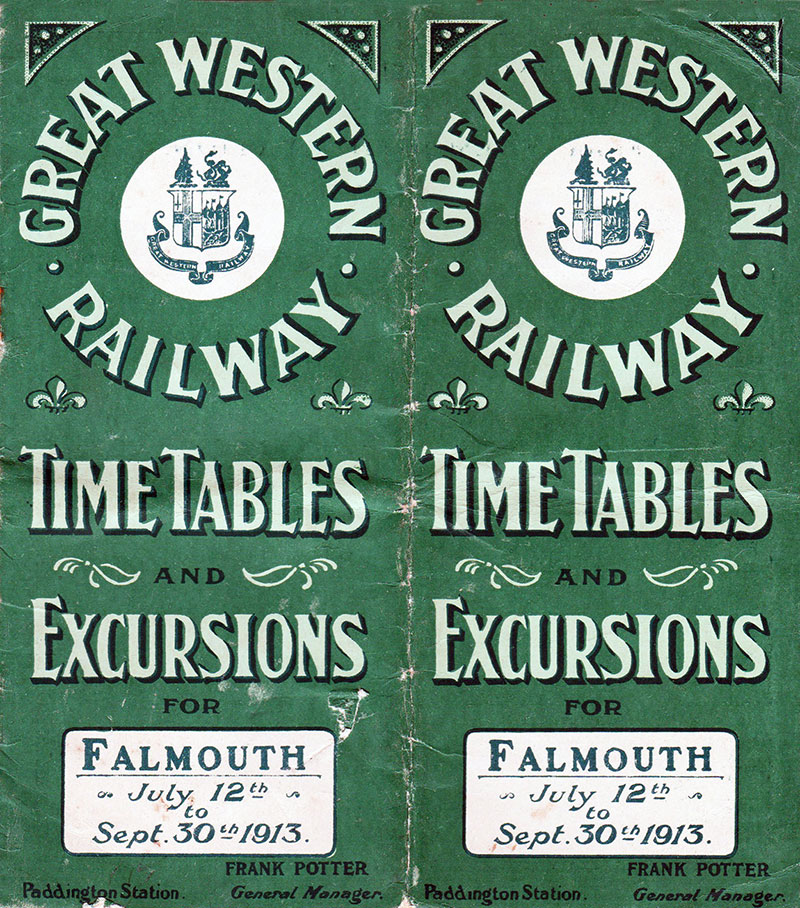
The GWR version is in fact a free issue to capture customers to a wide variety of standard regular service trains and special excursions, road motor services and even holiday period season tickets in Cornwall. Folded to just over 3 inches by 7 inches, it opened to 12 full pages of details. The design was much used in that pre-WW1 period to cover other areas of the system, and Falmouth itself was a significant choice given that it was the deep harbour which first drew the Cornwall Railway and then the GWR to provide a railway to it. Thankfully, though a shadow of its former self, the line from Truro to Falmouth is still with us today.
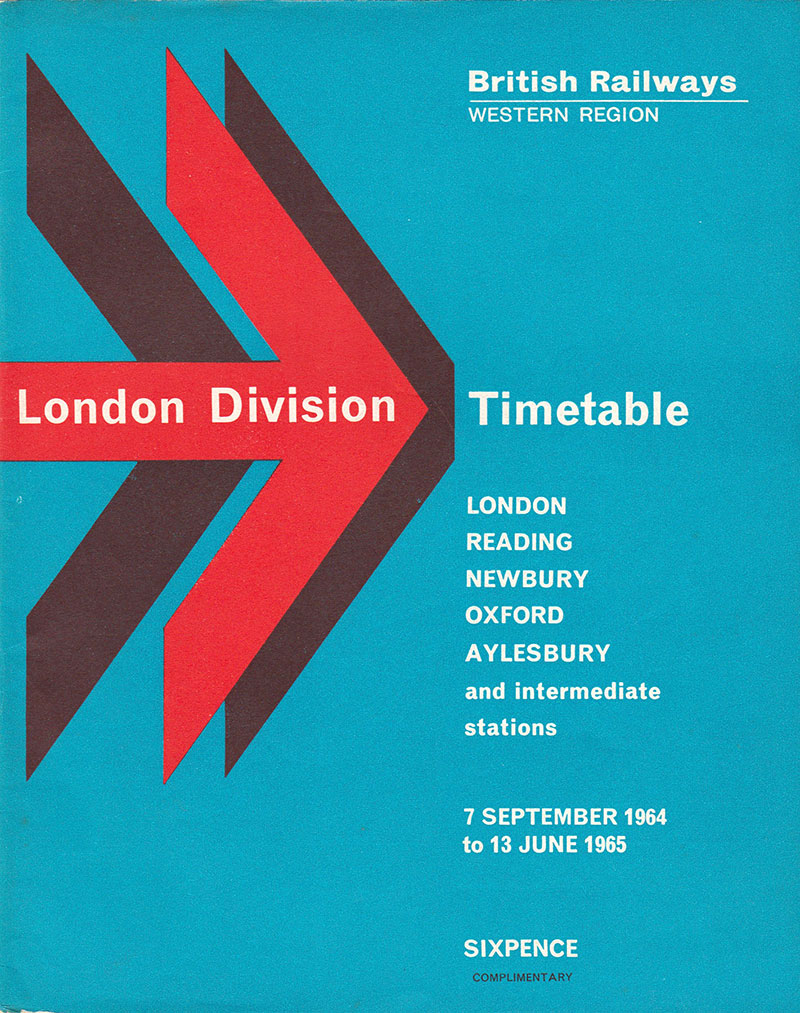
The BRWR version is also visually striking, and though carrying a sixpence purchase price it is overprinted ‘complimentary’ which probably explains why it has survived in such splendid condition as a keepsake of the person who held it. It is 8 inches by 10 inches in size, a standard format at that time, of 64 pages, and on its rear cover has the exhortation ‘Go by Train….Save time, save trouble, Go by Train!’
For our specific Didcot Railway Centre (DRC) and Great Western Society (GWS) interest, this copy has a corrective annotation, showing that the London Divisional Manager, had just changed from the name printed of G A V Phillips, to F D Pattisson. The latter was personally instrumental in making the then soon-to-be-decommissioned Didcot Engine Shed potentially a home for the locomotives and rolling stock of the GWS, who were then urgently seeking a viable alternative to its simple initial siding location at Totnes quay and Taplow goods shed. The rest as they say is history, and David Pattisson deserves a permanent public memorial at our fully accredited museum at DRC for his crucial contribution to our cause and our whole collection that has become of national importance. The Great Western Trust collection is proud to include documents that reflect his official BRWR role and his support to the GWS.
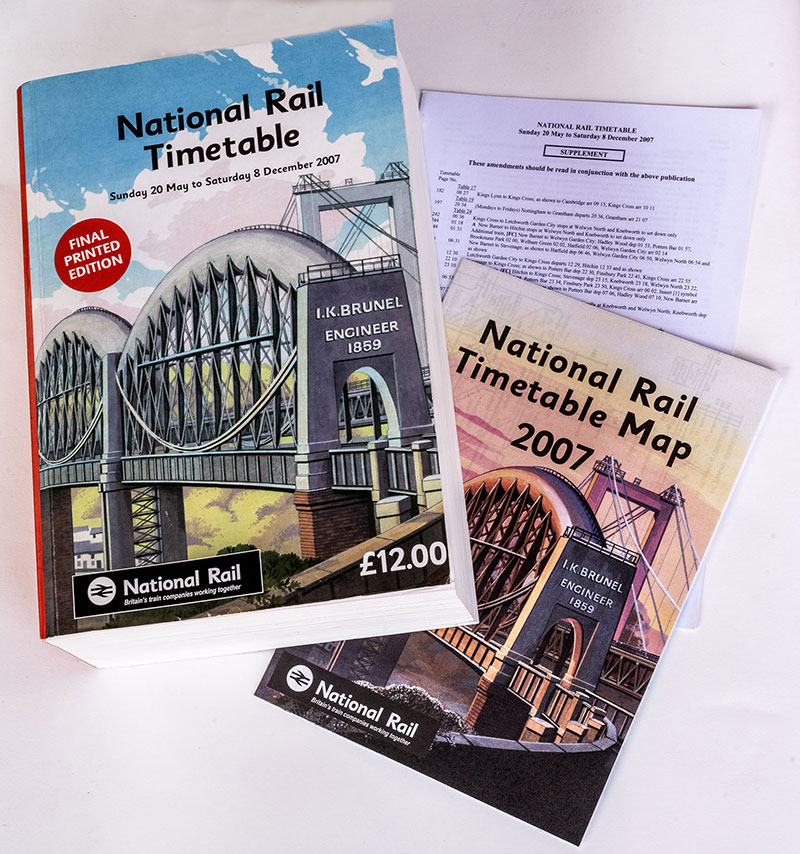
The third illustration is the National Rail all-system timetable of 20 May to 8 December 2007, billed on the cover as the ‘final printed edition’ and containing no less than 3,184 pages! This copy, with its cover illustration of Brunel's Royal Albert Bridge, is in the Great Western Trust collection. The national British Rail timetable had first been published as a single volume in 1974 at a price of 50p, and a copy of that one is also in the Great Western Trust collection.
Despite the May to December 2007 edition being announced as the “final printed” timetable, the publication was then taken up by the Middleton Press who continued its production until the winter 2019 to May 2020 edition, which really was the last.
The reason that Middleton Press was able to produce its national timetable in print was that in December 2006 Network Rail first made the timetable database freely available to download from their website. Indeed one can still do so. It is gratifying to see that Table 125 is still the one that shows trains from Paddington and Reading through Didcot to Bath, Bristol and South Wales. That was table 127 in early editions of the BR national timetable, until it was re-jigged to become table 125 from the late 1970s in recognition that the much loved InterCity 125 trains were first introduced on that route!
TUESDAY 20 JUNE
Postcards with a Difference - 2
Our July 2021 Blog first introduced examples from our Great Western Trust official and unofficial postcard collection.
Today’s Blog centres upon just one of our Great Western Railway official postcards, that unlike the GWR’s primary subject matter of places on its system or its locomotives, ships, ambulance trains and even its pictorial posters (all subjects we can return to in due time) it relates to its crack and most famous express train The Cornish Riviera Limited Express.
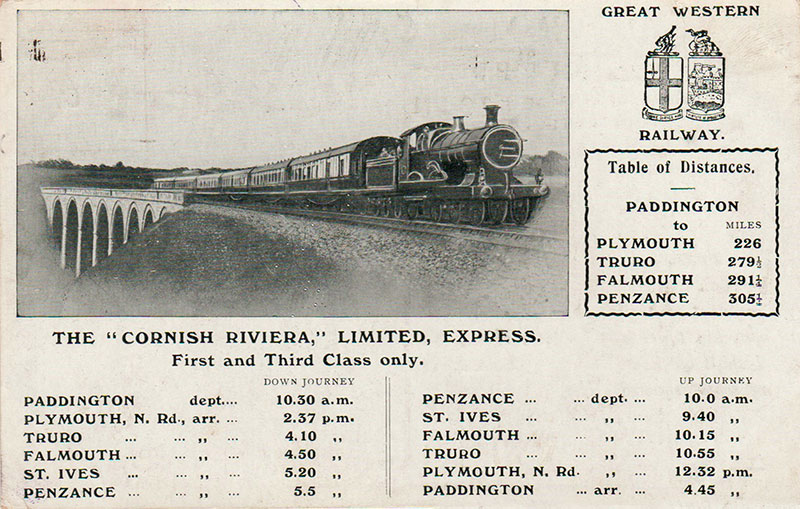
The striking if rather manipulated monochrome image is of a 4-4-0 loco on a six Dreadnought carriage formation just leaving a multi-arch viaduct. This does help to explain why it was definitely ‘Limited’ in that accommodation was hardly extensive and pre-booking was essential. The card helpfully includes the Up and Down train timings and the significant distance it traversed if you travelled the entire way! For those unfamiliar with the use of Up and Down in this context, Up was to London, and Down the reverse. This probably harks back into a very distant past, when London as our capital city was considered ‘the place’ of utmost importance, hence it was metaphorically speaking ‘the highest’ city, so one travelled ‘UP’ to it!
However interesting and novel the face of this postcard, we also illustrate its back, which tells another story of GWR commercial savvy.

Here we see that a GWR officer Mr H Weaver from the GWR Station Master’s Office at Paddington has used the card, franked at Paddington W at 5.30pm on 10 June 1910, to acknowledge an enquiry by having a pre-printed text explaining the one shilling (20 to the pound, about £5 at today’s value) cost, to reserve each seat on this express over and above the cost of whatever ticket was required for the journey itself. In fact it is nice for us GWR enthusiasts to see that the enquirer came from a Vicarage in Dunstable, on LNWR territory no less!
In finer detail, upon close inspection, the one penny postage stamp used has ‘G W R’ perforated upon it, that is it was an official use only stamp previously purchased in bulk by the GWR itself for official use only. Indeed every Station Master had to requisition for such stamps, and then answer for their proper use!
Even deeper detail is the very small print on the lowest left hand section “1000 – 9.09 W 177”. This strikingly shows that no less than 1,000 of these postcards were printed, to an order of 9-09 ie September 1909, the Order Reference being W177.
We can finally delight in the fact that this postcard survived from the 1,000 printed and probably E Sutton Esq of Dunstable (who is listed as the vicar of Eaton Bray from 1890 until 1916) retained it as a family heirloom that the Trust now holds in our permanent care.
Those of you with sharp eyes may notice on the top right hand of the rear cover ‘GWT/2022/D68.115’ in 2B pencil. That is our uniquely associated collection accession number identity of this postcard, which allows us to ensure its donor and its storage or display location are permanently recorded on our database. All items accessed into the Trust collection are treated likewise.
The Trust also has a print of the original photograph from which the postcard was adapted. This is dated 1905 and shows off the magnificent six-carriage set of 70ft long Dreadnought carriages which formed the Cornish Riviera at the time.

TUESDAY 13 JUNE
More Facts and Figures
Last week our Tuesday Treasure was a Facts and Figures poster. From the Great Western Trust archives this week we look at facts and figures in The Railway Handbook. It is to be honest a rather drab item but post war austerity was still a factor and good quality paper was in short supply. The cover features an image of a GWR King class loco with BRITISH RAILWAYS newly emblazoned on the tender.
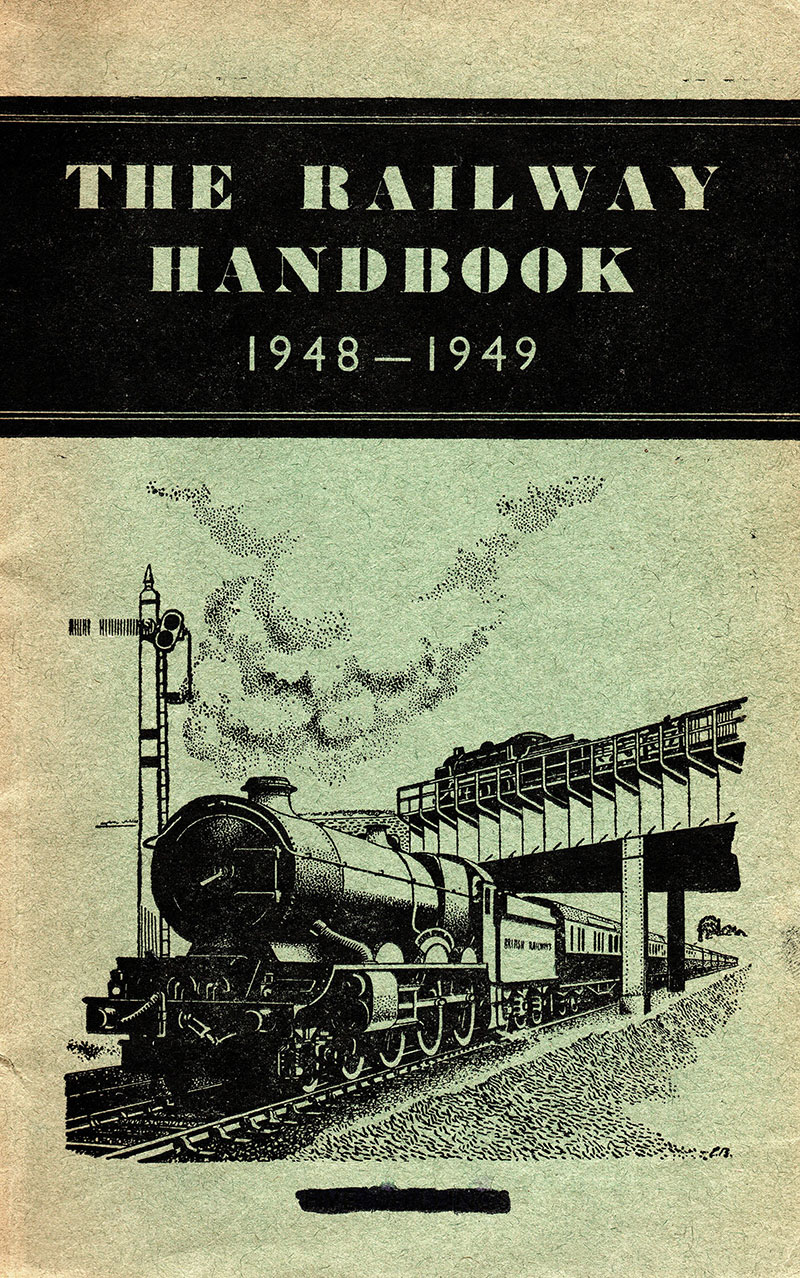
Established in 1934 by the Railway Publishing Company, this, the fifteenth edition dates from 1948 by which time it was published biennially. Its 120 pages contain a vast amount of statistical information on railways in the UK and throughout the world.
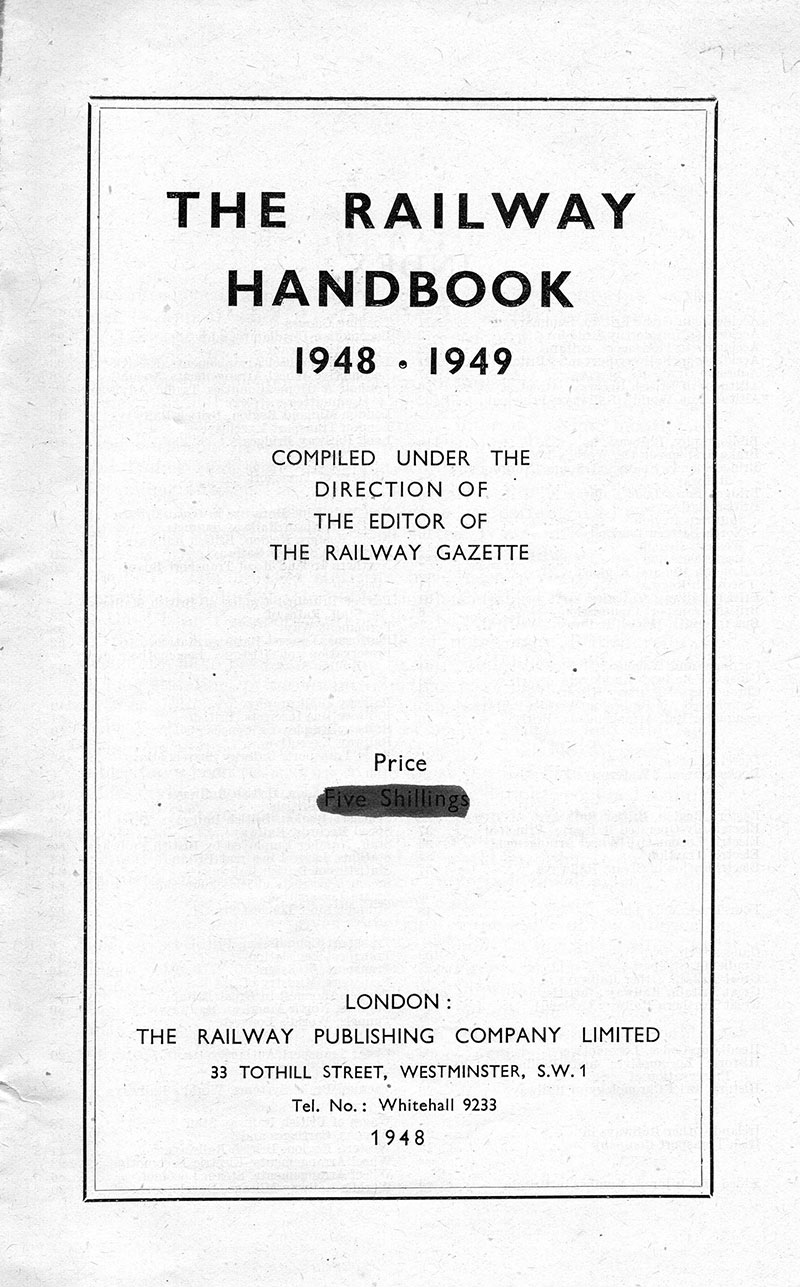
It is significant in being the first to appear since the passing of the Transport Act 1947 which came into force on 1 January 1948 and for the first time information is grouped into the six regions which came under the control of the Railway Executive of the British Transport Commission.

It records that the Western Region had 3,856 steam locos, 1 diesel electric loco, 37 diesel railcars, 5,791 passenger coaches, 87,403 goods wagons, 8,903 service vehicles, 1,148 horses, 10 steamboats, 208 miles of canal and 4 hotels.
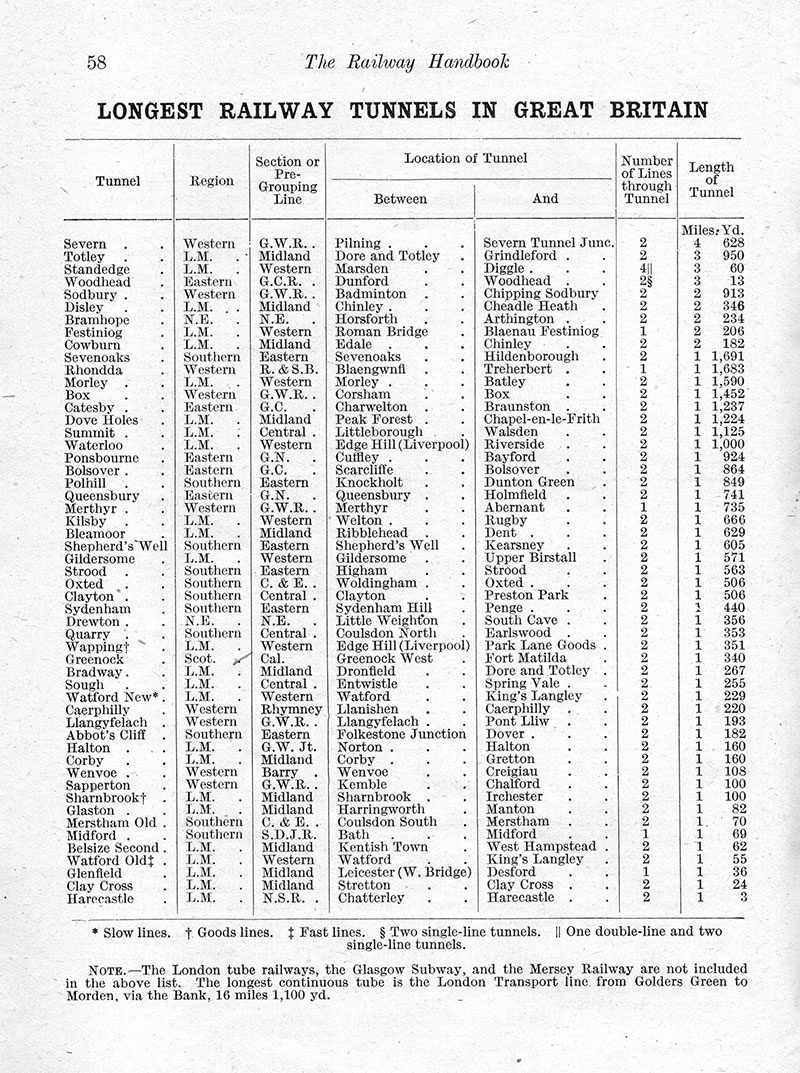
The book provided the railway student with information on a plethora of subjects including tunnels, bridges, notable accidents, rates of pay and even four-track main lines. Did you know that the New York Central Railroad had a world record unbroken 342½ miles of quadruple track between Castleton and Dunkirk? Or that on this day, 13 June, in 1842, Queen Victoria made her first railway journey, from Slough to Paddington? That’s one for the next pub quiz.
TUESDAY 6 JUNE
BR Publicity – Facts and Figures
The Nationalised railways as a new body had a massive task to perform. Not least of course to provide rail-based transport services, but also to explain to the tax paying public the massive undertaking that had been put into public ownership. Previous to that Nationalisation, each individual, and privately owned railway company, did its own publicity, although as road transport increasingly drained away lucrative goods transport, they were frequently joining forces in their publications.
Today’s Blog, draws upon an example from the Great Western Trust collection, of just one of those many BR initiatives aimed to scope in striking form what would otherwise be, a boring list of numbers.
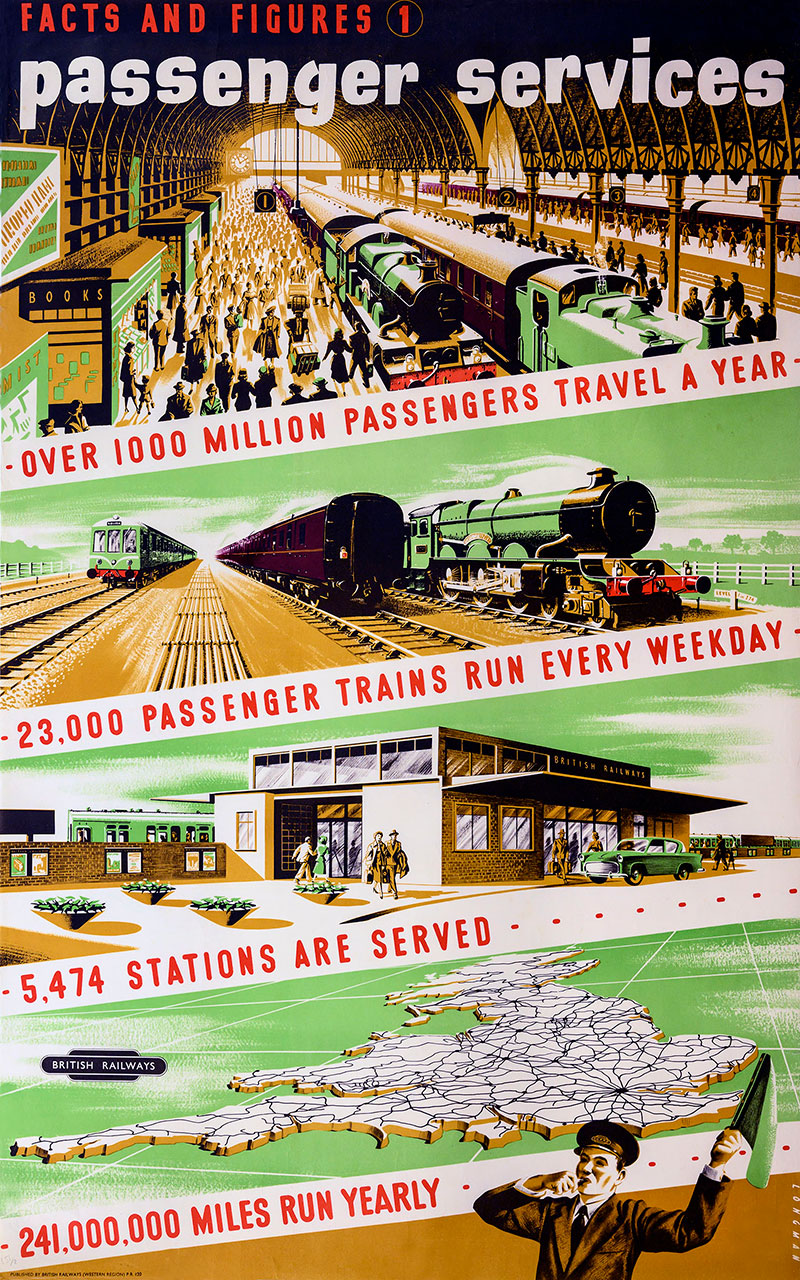
The double royal size poster (25 x 40 inches) illustrated is all the more appropriate we feel, as at least two of the artist’s images are of GWR/BRWR focus, Paddington station and a King class loco on an express train! It reveals at the top that it is ‘Facts and Figures – 1’, and that was because it was the first of a series, covering many diverse service facts and figures throughout the UK system, the other posters having other non BRWR regional images.
To its credit, the two station and train sketches are convincingly drawn, especially that of the famed platform 1 at Paddington, of which numerous official photographs were produced by the GWR and BRWR for a variety of their publications. The only issue to note is that Paddington station at the time was segregated into departures and arrivals sides. Platform 1 was on the departures side so it is very unlikely that a Castle class loco would be seen at the buffer stops on that platform, having arrived with its train!
The actual ‘numbers’ included in the poster are pretty amazing in themselves, and although it is undated, with steam and a DMU in the sketches it is likely to be around the late 1950s. The Office of Road and Rail (ORR) produces an Excel spreadsheet showing annual railway passenger journeys in Great Britain from 1872 to the present day. From a maximum of 2.186 billion in 1920, in the 1950s the number of passenger journeys hovered at just over 1 billion each year. They then declined gradually with the lowest figure 630,000 in 1982, before increasing to 812,000 in 1990.
Passenger journeys then increased at the beginning of the 21st century, passing 1 billion in 2004 and reaching a maximum of 1.738 billion in 2019 before Covid shutdowns took them back to 388,000 in 2020. They are now climbing again towards 1 billion. The methods of sourcing the passenger journeys data varied over the years so the comparison will not be 100% accurate. Since 2003 the data has been sourced from a program rejoicing in the name LENNON (Latest Earnings Networked Nationally Over Night). Imagine that!
The poster quotes 5,474 stations being served, while that number is currently 2,570 according to ORR.
Like so many publicity initiatives, BR drew upon long-established practices, in that beyond posters the ‘Big Four’ railway companies had produced booklets ‘Facts about British Railways’. The earliest in the Great Western Trust collection is undated but c1926, then we hold examples from 1932 to 1939 inclusive, and even in wartime issues of 1940, 1943 and 1944. BR itself then continued this series in January 1947 and though we have some gaps in our annual series, our last example is 1977!
Quite how the hard-pressed public viewed such efforts is hard to fathom, especially as the financial burden imposed became ever more alarming. How the national media of that era reflected upon the state of the railways is a topic of study. We should add that even the privately owned railways pre-1947, held archives of the contemporary press articles about their activities and performance, good or bad, and the Great Western Trust has examples in our collection. Public image and perception was never far from the minds and actions of all our railway organisations, and continues to this day, in rather varying degrees of responsiveness shall we say?
Didcot Railway Centre Newsletter
Stay up to date with events and what's going on at Didcot Railway Centre.
You may unsubscribe at any time. We do not share your data with 3rd parties.